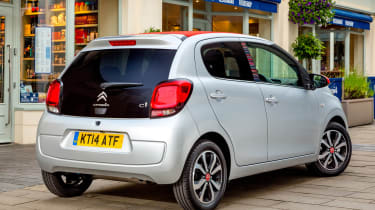Citroen C1 (2014-2022) review - MPG, CO2 and running costs
The C1 isn’t the cheapest city car to run, although there are only pennies in it in this market

The previous-generation C1 was offered with a diesel engine, but that was dropped in 2009, and the focus since has been on small-capacity petrol units.The C1 emits 108g/km in its most basic form, rising to 117g/km for the slightly heavier Airscape model. Economy, under stricter WLTP testing, is still impressive at 54.8 - 58.9mpg over the combined cycle.
Insurance groups
The little Citroen is not a common choice for fans of high-performance cars, or a target for thieves, and as a result insurance groups are reassuringly low. They range from group 7E for an entry-level Touch model, rising no higher than group 11E if you choose a five-door Origins version or an ‘Airscape’ Urban Ride model.
So if you’re a mature driver with a decent driving record, you’ll be laughing. Younger motorists, or those whose insurers consider them a liability, might want to look elsewhere, though. For example, the Kia Picanto range starts from insurance group 4.
Depreciation
The previous-generation Citroen C1, Peugeot 107 and Toyota Aygo turned out to be winners on the depreciation front; and although the C1 held on to the least value of the trio, there wasn’t a great deal in it. The counterpoint is that the Citroen was the cheapest of the trio to buy new. That remains the case today, with the C1 costing less than its equivalent Peugeot 108 and Toyota Aygo sister models.
Of course, considering the added competition in the city car sector these days, those rock-solid residuals have softened a fair bit, but with the starting prices so low the financial pain is reduced – even when you’re losing 60 per cent or more of the new value after three years. Plus, you can reduce your exposure further by agreeing a decent discount, which Citroen dealers are often open to negotiating.







